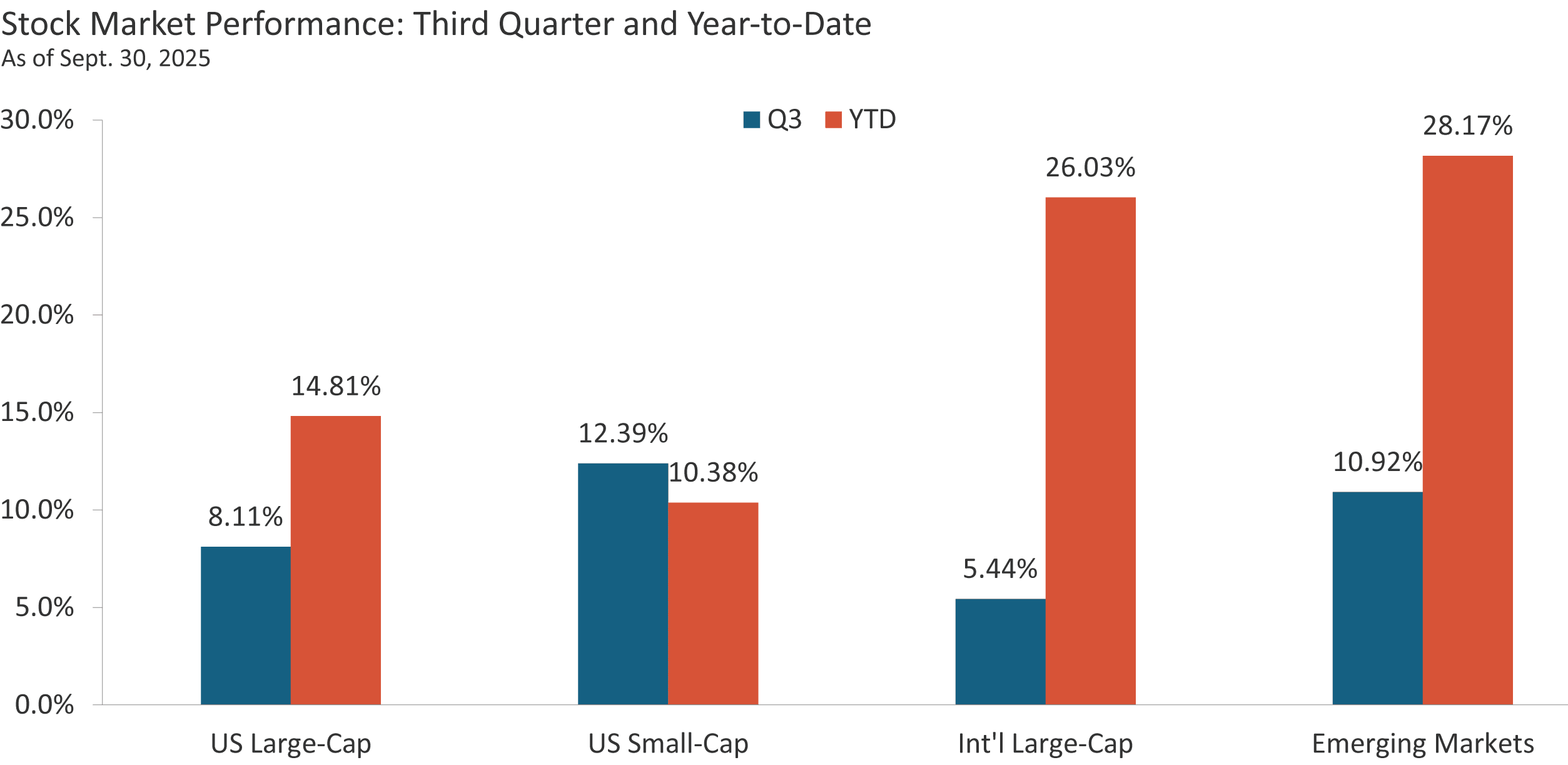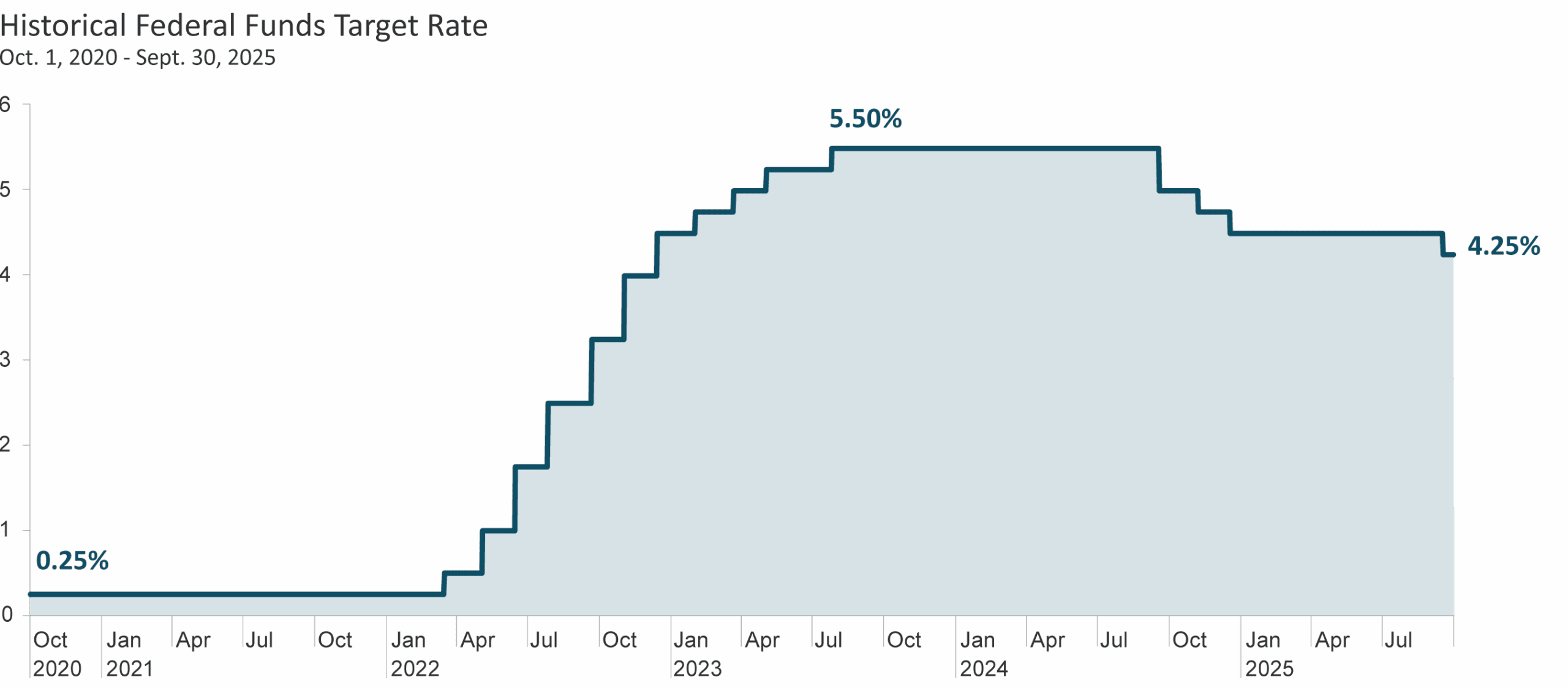Portfolios rise sharply in the third quarter Markets gained across the board by Terrence Demorest, Chief Investment Officer for Public Markets & ESG
by Terrence Demorest, Chief Investment Officer for Public Markets & ESG
The third quarter of 2025 delivered strong performance across global markets. Stocks continued to climb, led by technology and communication services, with Alphabet, Nvidia, and Apple among the key drivers as demand for artificial intelligence showed no signs of slowing. Bonds also delivered steady returns while investors weighed the Federal Reserve’s next move. In fact, the bond market produced a third consecutive quarter of positive returns. It was the first such streak since 2021 and demonstrated the resilience of the debt markets even in an uncertain policy and growth environment.
Alternative investments added to the momentum. Private market activity remained strong across both debt and equity strategies, and demand showed little sign of slowing. With both public and private markets advancing in tandem, alternatives continued to provide meaningful diversification and opportunity.
Looking ahead, corporate earnings, inflation trends, and the Fed’s path on rates will remain central to the market outlook. While there is increasing weakness in the job market, and inflation has not been fully tamed, the economy is showing numerous signs of continued strength, which can support further gains in the financial markets. Should interest rates fall meaningfully, investors in real estate would also benefit, following years of challenge coming mostly from higher interest rates.
Stocks
The third quarter began much as the second quarter ended, with markets moving past tariff concerns and focusing on the potential of artificial intelligence. Revised second-quarter GDP came in at 3.8%—the strongest since the summer of 2023—while the S&P 500 charged ahead, repeatedly setting new all-time highs. Optimism strengthened during earnings season as companies broadly beat expectations, while the prospect of lower short-term interest rates added a clear tailwind.
As the chart below indicates, market leadership shifted during the third quarter, as U.S. small-cap stocks staged a strong rebound after a difficult first half of the year. These companies, often more sensitive to borrowing costs, benefited from expectations of rate cuts. U.S. large-cap technology and communication services continued to contribute meaningfully, but the broadening of market strength was a notable development. The market dominance of foreign stocks this year is also reflected in the chart below.
For the quarter, the S&P 500 gained +8.11% while the global stock market (a mix of U.S. and foreign stocks) advanced +7.62%.
Alternatives – Growth
This quarter, we expanded our clients’ Alternatives – Growth portfolios with a new holding and an expanded allocation to private equity. Private equity offers diversification through strategies that acquire existing ownership stakes in private companies at attractive valuations while also co-investing alongside established managers on favorable terms.
Our most recent addition came in the final weeks of the quarter with an investment in the Stepstone Private Equity Strategies Fund (STPEX). Stepstone is a highly regarded manager with a long record of success in this asset class and strategy. We believe this position enhances our alternatives exposure and will contribute meaningfully to portfolio growth over time.
Alternatives – Income
Private credit continues to complement our private equity positions by providing steady income through lending to corporations and real estate sponsors. Over the past five years, private credit has proven resilient and consistent, and this quarter was no exception. The strategy delivered reliable returns even as interest rate dynamics shifted, reinforcing its role as a stable source of income within portfolios.
Bonds
The US bond market, as measured by the Bloomberg US Aggregate Bond Index, delivered another solid quarter, gaining 2.03%. Short-term bonds led the way as investors shifted attention from the Fed’s inflation fight toward concerns about risks to the labor market and broader economy. While many indicators still point to resilience, the labor market has begun to show clear signs of softening.
As the chart below illustrates, the Fed raised rates by a total of 5.25%, from near-zero (0.25%) in 2022 to a peak of 5.50%, in a determined effort to bring down inflation. Once those pressures eased, policymakers began shifting toward supporting growth, cutting rates by 1.25%. The latest cut came at the end of the third quarter, with the Fed moving again to support the labor market. Markets are now pricing in two additional cuts before year-end, though the Fed remains data-dependent with a watchful eye on inflation.
Looking ahead, bond performance will hinge on how the Fed balances fighting inflation and supporting healthy employment. A weaker labor market could lead to faster cuts, which would likely extend the bond rally. If economic growth remains firm, the path for rate declines may be slower. Either way, bonds are expected to remain an important source of stability and diversification in client portfolios.
Coming Soon
As we head into the final months of 2025, now is an ideal time to review and assess your year-end planning needs and objectives. For example, many clients use this period to evaluate current and future liquidity needs, charitable giving priorities, income tax considerations for the upcoming year, or longer-term estate planning concerns. Watch for Westmount’s annual year-end planning guide in the coming weeks. If you have any immediate year-end planning questions, contact your advisor directly or email advice@westmount.com.
Recent posts
Disclosures
Source for Historical Fed Funds Rate and Stock Market Performance charts: Bloomberg as of Sept. 30, 2025.
This content was prepared by Westmount Partners, LLC (“Westmount”). Westmount is registered as an investment advisor with the U.S. Securities and Exchange Commission, and such registration does not imply any special skill or training. The information contained in this content was prepared using sources that Westmount believes are reliable, but Westmount does not guarantee its accuracy. The information reflects subjective judgments, assumptions and Westmount’s opinion on the date made and may change without notice. Westmount undertakes no obligation to update this information. It is for information purposes only and should not be used or construed as investment, legal or tax advice, nor as an offer to sell or a solicitation of an offer to buy any security. No part of this content may be copied in any form, by any means, or redistributed, published, circulated or commercially exploited in any manner without Westmount’s prior written consent.
Past performance is not indicative of future results. Investment returns will fluctuate, and investors may experience a loss. No guarantee or representation is made that any investment strategy will be successful or achieve any particular results. All investments involve risk, including the possible loss of principal. Different types of investments involve varying degrees of risk, and there is no assurance that any specific investment will be profitable.
The financial advice and recommendations that we provide are tailored to each client’s unique circumstances. Please remember to contact us if there are any material changes in your financial situation or investment objectives, or if you wish to add or modify any restrictions to your investment portfolios.
If you have any comments or questions about this content, please contact us at info@westmount.com.


